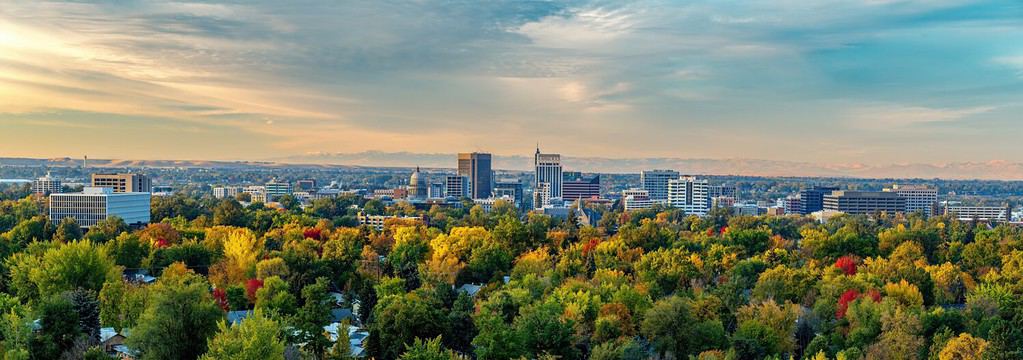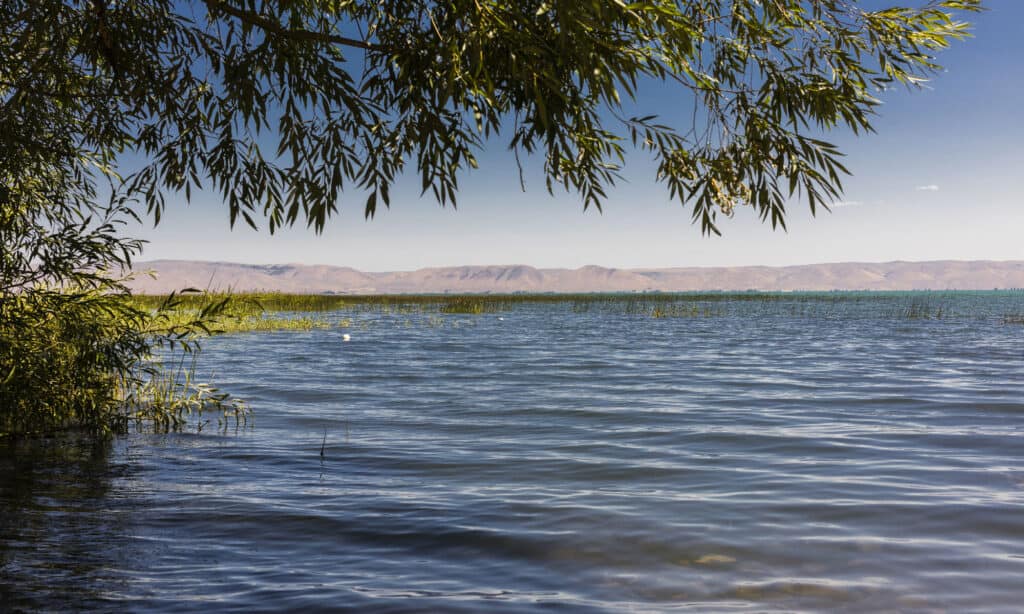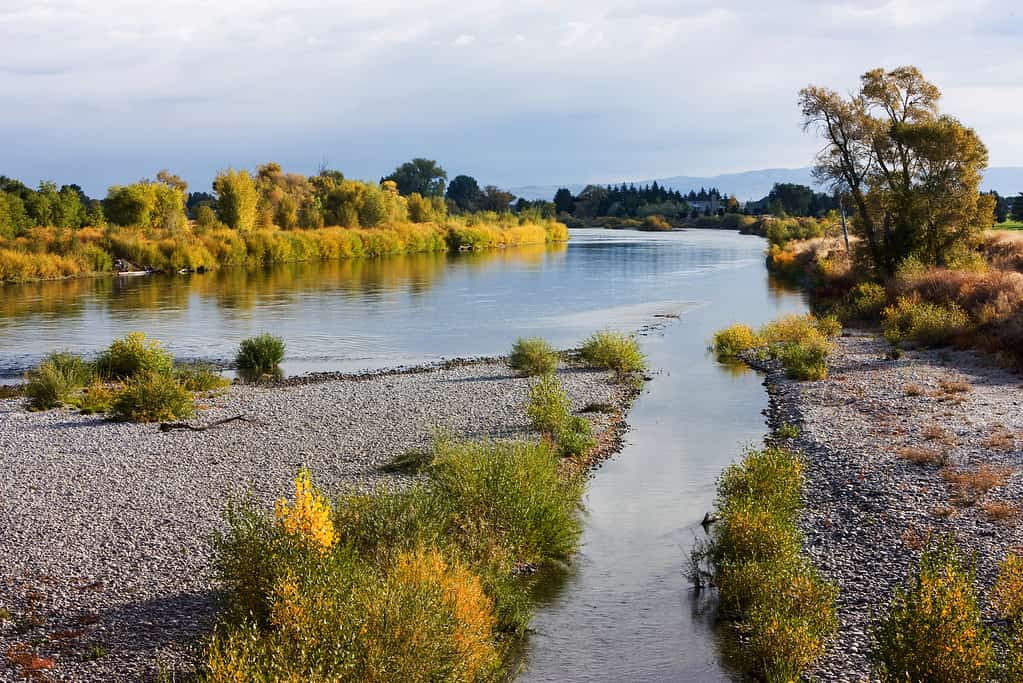Everybody knows Idaho for its pristine lakes, rugged mountains, and endless dense forests. But it also has a rich history dating back to the days of the Wild West. Settlers flocked to the area to start homesteads, strike it rich, or just make a fresh start. Idaho is still one of the wildest and most unspoiled states in the Union. However, it also boasts modern towns and cities with all the amenities residents and visitors could want. In this article, we’ll journey through time to explore the oldest cities in Idaho and what they have to offer.

Oh, and by the way, definitions of “city” vary widely. We’ve chosen to include towns with a population of at least 1,500 people (as of the 2020 census). You won’t find any ghost towns on this list.

Idaho draws tourists who love the great outdoors, but its historic cities have a lot more to offer than you might realize.
©CSNafzger/Shutterstock.com
1. Lewiston, 1861
Lewiston, Idaho, population 34,203, was founded in 1861, but it was an active place for explorers and settlers long before that. The first Europeans set up fur trading posts in the area for Hudson’s Bay Company. Lewis and Clark passed through the area in 1805 and the settlement that developed in the area was named for Meriwether Lewis. A gold rush in nearby Pierce helped draw people to the area, in search of adventure and fortune. And most remarkably, Lewiston is actually a Pacific Ocean seaport for the landlocked state of Idaho. Via a series of dams and locks on the Snake and Columbia Rivers, ocean-going vessels can travel all the way from the coastal port of Astoria, Oregon to Lewiston, Idaho, 430 miles away!
If you choose to visit Lewiston, here are some interesting activities you and your family might enjoy:
- Dogwood festival and classic car show: Every spring, blossoms fall from the dogwood trees and make the ground look like it’s covered in pink snow. And what goes better with flowers and pink snow than … classic cars? Check it out.
- “Hot August Nights”: Summer concert series of oldies from the 1950s-80s with stars like .38 Special and Eddie Money.
- Hells Canyon National Recreation Area: This canyon south of Lewiston is almost 8,000 feet deep (deeper than the Grand Canyon) and has ample opportunities for hunting, camping, rock climbing, hiking, rafting, and kayaking some of the best rapids in the Pacific Northwest. Trophy hunters flock to the area for the chance to bag a black bear, mountain lion, mountain goat, elk, or deer.
- If you prefer a less adrenaline-fueled experience, you can enjoy vineyards, wineries, museums, water parks, shopping, and much more.

Hells Canyon, south of Lewiston, has some of the best rapids in the entire Pacific Northwest.
©CSNafzger/Shutterstock.com
2. Boise, 1863
Boise, the state capital, has a modern population of 235,684. Before white people arrived in the area, it had long been an annual gathering place for the Shoshone and Bannock tribes where they caught salmon, had a large trade market, and wintered there to enjoy the hot springs at Castle Rock. As outsiders explored the area, it became a significant supply post and fur trading site.
Once gold was discovered nearby in 1863, large numbers of prospectors, traders, and U.S. army soldiers set up in the area and drove out the original inhabitants onto Fort Hall Indian Reservation in 1886. Immigrants from the Basque region of Spain were among those who came to seek their fortune but were systematically discriminated against in the gold mining operations. So, they turned instead to sheep ranching, one of their specialties back in the Old World. Today there are about 7,000 Basques living in Boise, the largest population of this ethnic group in the United States.
If you find all this history fascinating, you’ll enjoy Silver City near Boise, which grew up as a boomtown during the gold and silver rush and then was abandoned. But it’s been restored and opened as a tourist attraction to give a feel for what life was like over 150 years ago. If you’re interested in Basque culture, once every five years a gathering called Jaialdi takes place, and the next one is scheduled for 2025. Boise is Idaho’s biggest center of culture, with zoos, parks, museums, cultural centers, nature walks, music and theater festivals, comedy clubs, concerts, and film festivals. Any time of year, something is going on that would interest you in Boise.

Boise is a modern city and the center of cultural life for the state of Idaho.
©Charles Knowles/Shutterstock.com
3. Montpelier, 1863
Montpelier is a small city of 2,643 located on the path of the Oregon Trail not far from the Wyoming border. Mormon pioneers settled it in 1863. It got its name from the capital of Vermont, the state where Brigham Young was born. Most of the Mormons who settled in the area lived around Paris, Idaho, the county seat, so Montpelier became known as the “Gentile Town” because of the comparatively large numbers of non-Mormons living there. One of Montpelier’s claims to fame is that Butch Cassidy and his gang robbed a bank there in 1896, making off with $7,000-$14,000 in cash. Shortly afterward, Cassidy recruited a new member of his gang who took the nickname, the “Sundance Kid.”
Of course, with a history like that, there is a Butch Cassidy Museum, which just happens to be in the restored bank that he robbed! Among the town’s bars and clubs is the Butch Cassidy Saloon. For tamer fare, check out Papa’s Fine Chocolates for candies, caramel apples, popcorn, and other treats. As in all of Idaho, the outdoors is one of the greatest attractions. Around Montpelier you can go tubing, camping, golfing or take a cave tour. Bear Lake (the “Caribbean of the Rockies”) and the National Oregon/California Trail Center are other tourist draws.

Bear Lake, Idaho has been called the “Caribbean of the Rockies.”
©Michele Vacchiano/Shutterstock.com
4. Malad City, 1864
4,233 people call Malad City home. It’s an unfortunately named place. After a group of explorers became sickened in the area, they named it “Malade” which means “sickly,” perhaps as a warning to future travelers. Later it was discovered that the problem was not the water itself but eating beaver meat that had been poisoned with a local hemlock species. Later the area was settled and developed by Welsh immigrants affiliated with the Church of Jesus Christ of Latter-Day Saints. It was a strategic point on the journey between Salt Lake City and Butte, Montana that particularly began to grow after the railroad came through.
Malad City has a couple of cultural attractions that draw visitors to the area: the Oneida County Pioneer Museum and the Malad Welsh Festival. The latter event is a celebration of Welsh music, stories, and traditions. Protected forests and grasslands in the area give visitors the chance to see truly unspoiled habitats where elk, moose, waterfowl, birds of prey, and songbirds abound. Camping, thermal spas, cross-country skiing, hiking parks, golfing, wineries and vineyards, nature centers, botanical gardens, dog parks, craft fairs, and farmers’ markets round out the list of all the fun things you can do in Malad City.

Elk are one of the iconic American species you can spot in the wild areas around Malad City, Idaho.
©Bradley Wakoff/Shutterstock.com
5. Weiser, 1871
Weiser, Idaho was founded in 1871 and has a present population of 5,630. Nobody quite knows where it got its name. However, the two leading contenders are Peter Weiser, a soldier who went on the Lewis and Clark expedition, and Jacob Weiser, a successful trapper and miner. The settlement was started when a couple of families built a ferry to cross the Snake River. From this beginning, the city went on to become the center of a thriving farming community. By the 1940s, the region had a plant to process dehydrated potatoes and onions. And the government was one of its biggest customers. The area was also touched by the budding technology revolution at the end of the 20th century. Hewlett Packard purchased land and built Micron Technology there.
Weiser has some quirky, fun things to do. How about the “Oldtime Fiddler’s Festival?” It’s held every year in June. There’s also a trampoline park. You can go on a Ninja course, learn stunt falls, and discover how to fly on the trapeze. How about skydiving or hot-air ballooning? You can do both of these in Weiser (but not at the same time). There’s a wine bar, gift shops, and bicycle tours. The Warhawk Air Museum has aircraft and automobiles from the 1940s and 50s on display. If you get bored in Weisier, well, maybe try the potatoes?

Weiser is situated at the confluence of the Weiser River with the Snake River,
©Tucker James/Shutterstock.com
Summary of the 5 Oldest Cities in Idaho
Here’s a recap of the five oldest cities in the state of Idaho that we took a close look at:
| Rank | City | Date Founded |
|---|---|---|
| 1 | Lewiston | 1861 |
| 2 | Boise | 1863 |
| 3 | Montpelier | 1863 |
| 4 | Malad City | 1864 |
| 5 | Weiser | 1871 |
Idaho Is Ready for You. Are You Ready for Idaho?
Maybe you’ve heard people comment that Idaho is boring because “all it has are potatoes.” So, first of all, potatoes are not boring when there are 26 varieties of them! And everything (and we do mean EVERYTHING) tastes better with mashed potatoes on the side. But in this article, we’ve tried to give you a little taste of the non-potato side of Idaho. This includes OId West history, gold, wild animals, and the deepest canyon in North America. And we can’t forget learning ninja skills, riding rapids, or discovering Idaho’s port on the Pacific Ocean. In any season of the year, you’ll find Idaho a beautiful, exciting, and friendly adventure. And maybe, just maybe, all those gold prospectors overlooked a single nugget that you’ll take home for yourself!
Thank you for reading! Have some feedback for us? Contact the AZ Animals editorial team.








